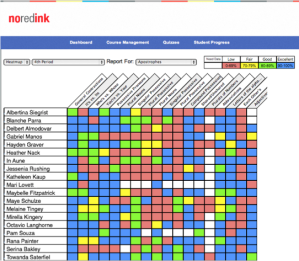The College Board recently announced it is changing the SAT to better align with schoolwork. While I applaud their initiative to make the test relevant to what students are actually learning, emerging efforts in learning analytics and data backpacks will cause a shift in the underlying model of standardized tests.
Think about it: why would we sit students down in an inauthentic testing environment and ask them to perform when we have data on how they perform every single day, how long it has taken them to reach that level, and exactly how well they understand each foundational concept along the way?
I am pro-measurement but anti-test. The technology tools being developed in education today will gradually replace standardized testing by offering a snapshot of student understanding. Consider the three examples below as replacements for standardized testing, showing progress in grammar, math, and behavior.
Example 1: No Red Ink provides an in depth heat map of grammar understanding. Students work their way up colors, and if they are all blue then they have demonstrated understanding of the subject. Each block tests the basics, nuanced understandings, and edge cases of different grammar concepts.
Example 2: Khan Academy provides an entire concept map of interlinked algebra concepts, showing a snapshot of a students understanding and what ideas they are prepared to learn next. This type of data is much more valuable than a 680/800 on a math test because you can see how they have approached learning, explored, and pushed themselves and silly mistakes are not overvalued in the algorithm.
Example 3: Class Dojo feeds back data about student behavior, capturing qualities like teamwork, creativity, or talking out of turn. Their data dashboards can present viewers with an understanding 100% unavailable by current testing methods.
Proponents (I am paraphrasing Jeb Bush) will tell you that a testing environment is good — that, in the real world, students need to perform in a given moment and they need to learn to deal with the stress. From this perspective, allowing performance on tools like Khan Academy or NoRedInk to count makes no sense because students can practice and refine their solutions. Yet the real world is much more forgiving —I am constantly doing drafts of papers, revisions to presentations, and consulting the team when I need help evaluating investment opportunities.
The gradual shift away from standardized testing towards the performance snapshot model will change the conversation from “what was my grade” to “how can I better understand?” And what better goal of primary and secondary education than to have students exit with an inquisitive drive and having learned how to learn?


